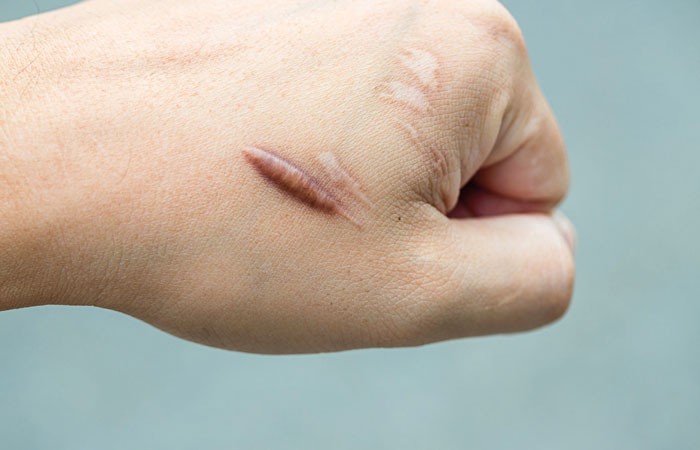In OTC Category Reviews
Follow month by month updates on topics including asthma, mental health and skin conditions and be able to provide informed advice to customers at the counter.Bookmark
A recent survey by The British Skin Foundation (BSF) found that four out of five of us believe that appearance is important to our general wellbeing, yet over half of those with a skin condition feel judged by others.
The emotional effects of scars can be particularly psychologically distressing, especially for people with facial scars, and lead to social isolation and depression. So, what causes scars, and what can pharmacy teams do to help customers treat them and make living with them more bearable?
How scars form.
Scars are a natural part of the body’s healing process after tissue is wounded or injured. When the skin is damaged the tissues break, causing the release of a protein called collagen to heal and strengthen the wound.
New collagen continues to form for several months, and the blood supply increases, leading to scarring, which can initially be raised and lumpy. Although scars are permanent, they can gradually become smoother and softer over the first couple of years, but it’s unlikely they’ll fade any more after this.
Focus on first aid
With more than 2.7 million accidents occurring in UK homes each year it is common for those injured to come to the pharmacy for advice or care for a range of first aid situations such as minor scrapes and grazes, burns, or even customers having an epileptic fit or an anaphylactic reaction.
"There are many occasions when pharmacists and their teams are called on for first aid help and advice", says Katey Haycock, learning and development pharmacist at the National Pharmacy Association (NPA). "Workplaces may delegate first aid responsibilities to team members other than the pharmacist, so anyone administering first aid should only do so within their competence, and pharmacy teams should have an awareness of how and when to refer patients for emergency treatment."
The Association of Pharmacy Technicians UK (APTUK) has a range of training modules, advice and articles on how to respond quickly and effectively to emergency situations in the pharmacy. St John Ambulance and The Red Cross also run first aid courses.
At-home first aid kits
As well as keeping a well-stocked first aid kit in the pharmacy, teams can help customers create their own kit for emergencies at home.
St John Ambulance suggests the following essential items:
- Sterile gauze pads – to clean wounds and as dressings or padding. They can also improvise as an eye dressing
- Adhesive tape including some hypoallergenic tape – to secure dressing
- Adhesive dressings or plasters – to cover wounds. If someone in the household is allergic to plasters, look for self-adhesive dressings that use hypoallergenic tape/material
- Bandages – conforming bandages are ideal for holding dressings in place. Open-weave roller bandages can also be used to hold dressings in place but won’t put pressure on wounds. A triangular bandage is useful to make a sling or improvise a splint or tourniquet
- Cleansing wipes – to clean wounds if out and about without access to running water
- Scissors – ideally blunt ended to avoid injuries
- Safety pins – to secure bandages
- Tweezers – to remove splinters and some insect bites
- Personnel protective equipment – face mask, gloves, hand sanitiser and aprons.
Other things to consider
- Ice packs – frozen peas are a cheaper alternative and will mould to an injury. They should be wrapped in a tea towel and not applied directly to the skin
- Medications – pain relief that will cover the age range of the people the kit is designed to support. Antihistamines to treat mild to moderate allergic reactions. Rehydration salts to replace the electrolytes lost with diarrhoea and vomiting and other causes of dehydration.
With all these things it is important to check the use by dates and conditions on a regular basis. The free St John Ambulance First Aid App is also a comprehensive source of first aid advice.
Types of scars
“Support customers to be realistic that most scars are permanent”
Historic scars
For long-term scars, Lucy says there are additional services which are available to customers: "Some of which may be offered in pharmacy and some which may need referral to other providers – such as microneedling, laser therapy or, in some cases, dermal fillers."
Ioannis says soft tissue manipulation techniques can also be "invaluable" in improving scar tissue characterised by lack of pliability/softness, but Dr Aslam stresses that managing customers’ expectations is vital here: "Pharmacy teams should support customers to be realistic that most scars are permanent, and no OTC product will help if the scar has been there a long time," she says.
Scar camouflage
If the scar can’t be treated, people may choose to buy specific skin camouflage products to cover it or see a qualified camouflage therapist. "Products that are designed to cover scars can be especially useful for customers with facial scarring and, in certain circumstances, can be available upon prescription", says Lucy.
Customers with a large area of skin to cover who live in England or Scotland can access the Skin Camouflage Service run by the charity Changing Faces (changingfaces.org.uk/services-support/skin-camouflage-service), either via a GP or through self-referral. Their fully trained skin camouflage practitioners will help find a good colour match for the person’s skin tone and teach them how to apply the make-up. The products are long-lasting, waterproof and suitable for the face or body, and can stay in place for two or three days.
Scars can also affect different skin types in different ways. "For example," says GP Dr Nisa Aslam, from Typharm’s Skin Life Sciences Foundation, "darker skins can get darker keloid areas, and as smoking thins the skin and affects the blood supply to the affected area, smokers can end up with poorly healed scars."
Dr Aslam prescribes camouflage - makeup and has seen how important it can be. "Some patients find it really difficult to live with their scars", she says, "and I know that camouflage - makeup can make an emotional and mental health difference to people. It’s important to remember how emotionally upsetting any kind of perceived disfigurement can be – driving many people to be suicidal – so we have to take this seriously, and community pharmacy teams are in the ideal place to help."
Treating scars
These can be used on healing skin to help soften and flatten a scar and relieve itching and discomfort.
These can be used to treat some keloid and hypertrophic scars.
This can be used to try and flatten keloid scars.
This can reduce scar redness by targeting the blood vessels in the excess scar tissue. However, this must be done by a fully trained medical practitioner with experience in improving scars.
This used liquid nitrogen to freeze keloid scars in the early stages and stop them growing. A side effect is that it can lighten the colour of the skin in the area being treated.
These can be injected to 'plump up' pitted scars, but treatments can be costly and results are usually temporary.
This can sometimes improve a scar but is an invasive treatment that may not be suitable for everyone.
These are usually used under specialist supervision for treating large burn scars or after skin grafts.
OTC scar management
Many scars will gradually fade over time, especially when managed with the support of over-the-counter (OTC) products available at community pharmacies. One simple OTC product that may help is an appropriate skin cream.
"Although there is no strict medical evidence of effectiveness, Vitamin E cream is often recommended for managing scars, as the act of massaging a moisturiser into a scar can help the skin remain supple and ease tension," says Lucy Morris, Numark patient services manager. "And as scars can be more sensitive to sun, it is important to protect scar tissue from any extra damage with a sun screen."
Ioannis Goutos, plastic surgeon and BSF spokesperson, says another evidence-based approach for linear scars is the application of paper microporous tape. "This has a variety of different actions including the provision of external support to the fresh scar as well as preventing water loss and contributing to a better moisturisation status", he says, with patients "encouraged to apply a strip of paper microporous tape to the scar for a period of eight to 12 weeks following a wound healing."
As with so many conditions, Dr Aslam says prevention is better than cure. "By improving your overall health, you can optimise scar healing", she says, "so pharmacy teams have a role to play in educating customers about the importance of having good nutrition including all the necessary vitamins and minerals, as well as proteins since amino acids are the building blocks to heal the skin."
Act fast
Ioannis says prompt and appropriate wound care/scar management is also key in order to ensure optimal long-term scar quality. "There is emerging evidence in the scar literature that intervening at the earlier stages with minimally invasive techniques – such as lasers – can have a beneficial effect in scar remodelling," he says.
However, with laser therapy not available to everyone, Dr Aslam’s recommendation is at least to act fast. "It’s easier to lessen scars during the wound healing stage than afterwards", she says, "so customers should do what they can, as soon as they can, using the appropriate OTC products such as emollients alongside good nutrition including boosting vitamin C and E, with a referral to their GP to start medical treatment if needed".
C-section scars and stretchmarks
Nisa says problems related to C-section scars are one of the most common scarring issues she sees as a GP but adds: "C-section scars can get good results from early treatment, and a key point to educate customers on is also spotting signs of infection. If the wound is red, hot, or weeping, refer your customers to see their midwife or doctor for antibiotics to treat any infection and prevent the scar from worsening."
Acting quickly can also prevent or lessen stretch marks, according to advice from pharmacist Deborah Evans, managing director and owner at Pharmacy Complete and Remedi Health, and a spokesperson for Bio-Oil.
"Stretch marks are more likely to occur during rapid growth, weight gain or during pregnancy", says Deborah, "and itching can often be the first sign. To help prevent stretch marks in pregnancy, massage a moisturiser or an oil in daily to improve skin elasticity and help it to stretch. New stretch marks will fade from red/purple to fine silvery lines that are harder to see but massaging a cream or oil into the skin can help this process."
Sponsored
 Sponsored education
Sponsored education
Challenge your thinking on warts and verrucas
Discover different treatment options for warts and verruas and when to recommend them to your customers, based on their individual needs
 Sponsored education
Sponsored education
A different approach to pain
Complete this interactive video to rethink your pain recommendations and ensure you offer every customer the most appropriate advice








Record my learning outcomes